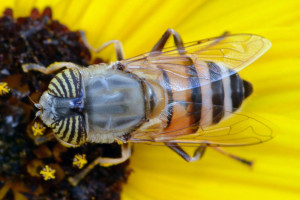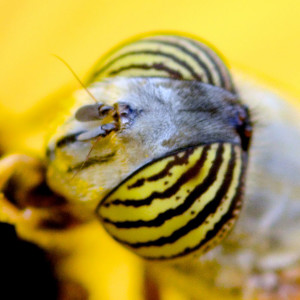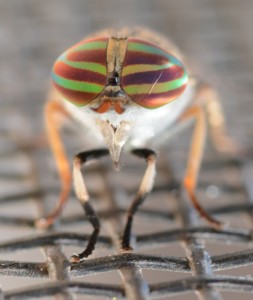I like to start the new month with a photo sweep of the yard, just to record what’s present. I’m still trying to re-establish my monthly inventory that got zapped when my hard drive failed and my backup wouldn’t restore, so I’m putting some extra effort into it these days. (And making sure that my data is backed up redundantly.)
This month I found a new species for the yard: the Band-eyed Drone Fly (Eristalinus taeniops) a flower fly from the Old World that was introduced (accidentally, I understand) into Florida back in the 1980s. (You can read more about it here.)
Like our common urban birds (Blue Jay, Cardinal, House Sparrow, etc.), it’s a synanthrope—an organism that lives in close association with humans and their modified environment. (Technically, they’re hemisynanthropes, “close associates of human ecosystems” but not completely dependent on them.)

It has a fat, bee-like body, like many members of this large fly family, the Syrphidae, but the eyes are completely distinctive:

They look a bit like the eyes of some horseflies, except that the stripes are vertical rather than horizontal:

These eyes are unique, as far as I know, in the “flower fly” family, but as far as I know doesn’t take you very far.
According to my “fly guy,” Stephen A. Marshall, drone flies (genus Eristalis) “are easy to find, especially at yellow flowers, around which they often exhibit stereotypical mating behaviors. Males sometimes defend limited mating territories and court flower-visiting females by ‘singing’ to them with a specific hum as they hover above prospective mates” (307).
According to the map on this species’ web page at the Biological Survey of Canada, its known range in North America is the two areas I’ve called home for most of my life: Southern California and south Florida.

Etymology uncertain; the New Century Dictionary only notes Eristalis as “New Latin” coined by Latreille in 1804; its Latin meaning is a precious stone, although it’s not known which one. Eristalinus is the diminutive. Taeniops means “ribbon-eyed.”
References
Marshall, S. A. 2012. Flies: the natural history and diversity of Diptera. New York: Firefly.
Thompson, F. C., Fee, F. D., Berzark, L. G. 1990. Two immigrant synantrhopic flower flies (Diptera: Syrphidae) new to North America. Ent. News 101(2):69–74.
